Risk and Uncertainty in Business Finance Explained
Notes on Risk and Uncertainty in Business Finance
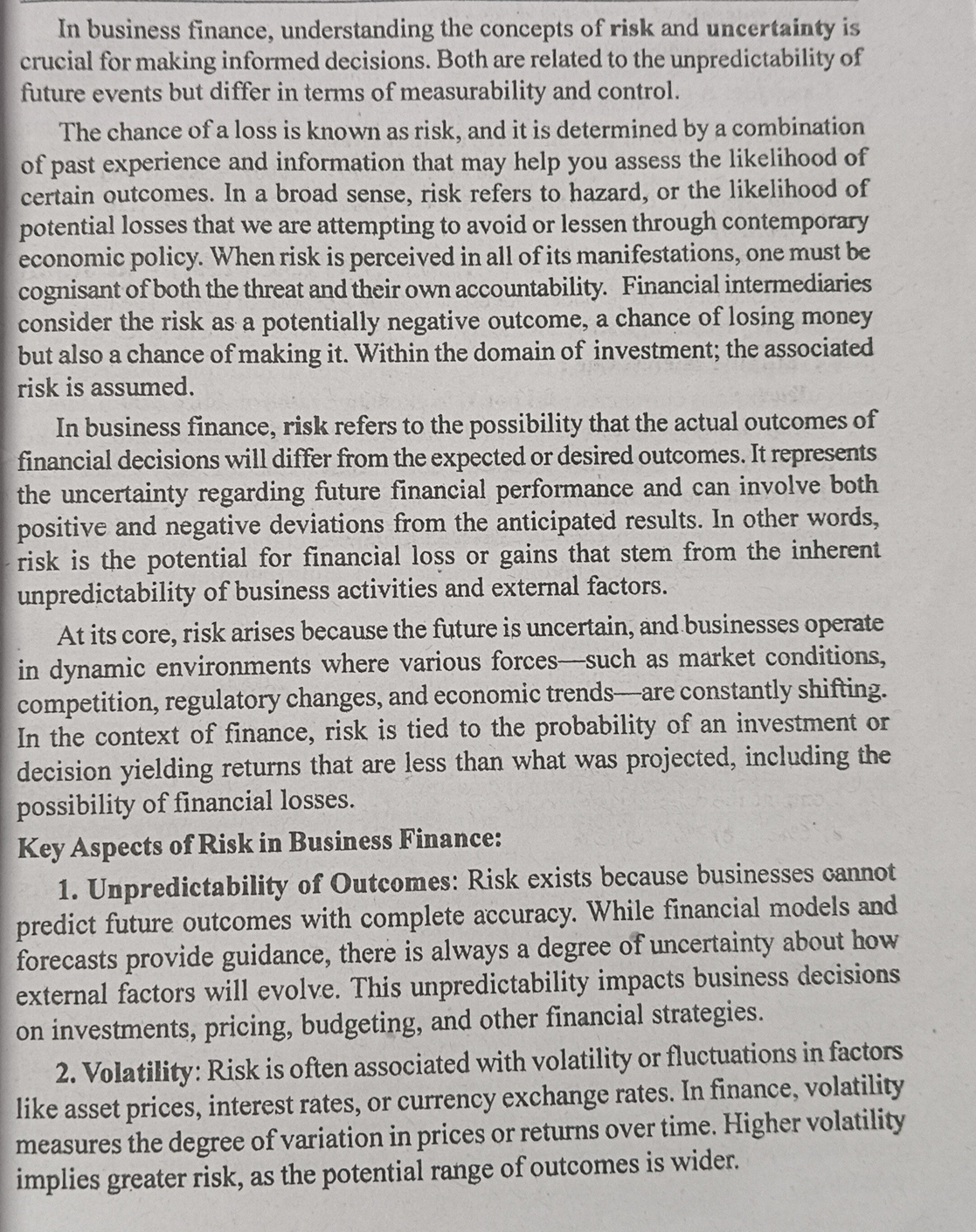
Key Concepts
- Risk vs. Uncertainty:
- Risk is measurable and involves potential losses or gains based on known factors, while uncertainty relates to unpredictability and is harder to quantify. Understanding both is essential for informed business decisions.
Definitions
-
Risk:
- The chance of a loss, identified through past experiences and data. It involves making assessments to anticipate potential outcomes. Business financing involves risk acceptance.
-
Uncertainty:
- Refers to the unknown aspects of future outcomes. It impacts financial decisions and reflects the range of potential deviations from expected results.
Key Aspects of Risk in Business Finance
-
Unpredictability of Outcomes:
- Businesses face challenges predicting future outcomes accurately, which can change based on external factors. This unpredictability affects strategic planning and resource allocation.
- Thoughts: Regular reviews and updates of financial models can help mitigate the impact of this unpredictability.
-
Volatility:
- This involves fluctuations in market conditions, such as asset prices, interest rates, or currency exchange rates. Higher volatility indicates greater risk, as the variations in outcomes widen.
- Additional Information: Businesses can use hedging strategies to manage exposure to volatile markets, thereby minimizing risk.
Summary
Understanding risk and uncertainty in business finance is crucial for effective decision-making. Recognizing the key aspects, such as unpredictability of outcomes and volatility, enables businesses to develop strategies that account for these factors, aligning financial goals with market realities.
Extended readings:
Volatility Risks in Business Finance

Key Points
A. Stock Market Volatility
- Definition: The risk associated with fluctuations in the stock market that can suddenly affect businesses holding significant equity investments.
- Impact: Companies may face unexpected gains or losses, altering their financial position rapidly.
- Thoughts: This highlights the importance of diversification in investment strategies to mitigate potential losses during turbulent market conditions.
B. Currency Exchange Rate Volatility
- Definition: Risks stemming from exchange rate fluctuations when companies operate in multiple countries.
- Example: A U.S.-based company selling goods in Europe may see reduced revenue if the euro devalues against the dollar.
- Impact: Unpredictable changes in revenue due to currency fluctuations can complicate financial planning.
- Thoughts: Companies can utilize hedging strategies to protect against adverse movements in currency exchange rates, helping to stabilize their financial outcomes.
C. Commodity Price Volatility
- Definition: Pertains to the instability of prices for raw materials (like oil and metals).
- Example: Industries reliant on oil prices can find their cost structures disrupted due to sudden price increases.
- Impact: This volatility can have a cascading effect on overall profitability.
- Thoughts: Businesses should develop cost forecasting models to prepare for potential price swings in commodities, ensuring they remain agile in resource management.
D. Interest Rate Volatility
- Definition: Changes in interest rates that can affect companies with substantial debt.
- Example: A rise in interest rates can increase the cost of servicing debt, impacting profitability.
- Impact: Decreased borrowing can occur during economic slowdowns, which further affects business growth.
- Thoughts: Effective interest rate risk management strategies, such as fixed-rate loans, can help companies stabilize their financial health amidst changing rates.
General Thoughts on Volatility
- Understanding Volatility: Recognizing the various forms of volatility is essential for businesses to make informed financial decisions.
- Proactive Management: Businesses should incorporate risk assessment frameworks and dynamic strategies to withstand the impacts of volatility in various forms.
Summary Table of Volatility Risks
| Type | Definition | Example | Impact |
|---|---|---|---|
| Stock Market Volatility | Fluctuations in stock prices affecting equity investments | Sudden market downturn | Unexpected gains or losses |
| Currency Exchange Rate Volatility | Risks from foreign exchange fluctuations | U.S. company selling goods in Europe | Reduced revenue due to currency depreciation |
| Commodity Price Volatility | Instability of raw material prices | Oil price surge impacting aviation industry | Disruption in cost structures |
| Interest Rate Volatility | Changes in interest rates affecting debt servicing costs | Increased servicing costs during rate hikes | Potential slowdown in borrowing and growth |
By understanding and preparing for these volatility risks, companies can enhance their resilience and promote financial stability.
Extended readings:
Volatility in Business Finance
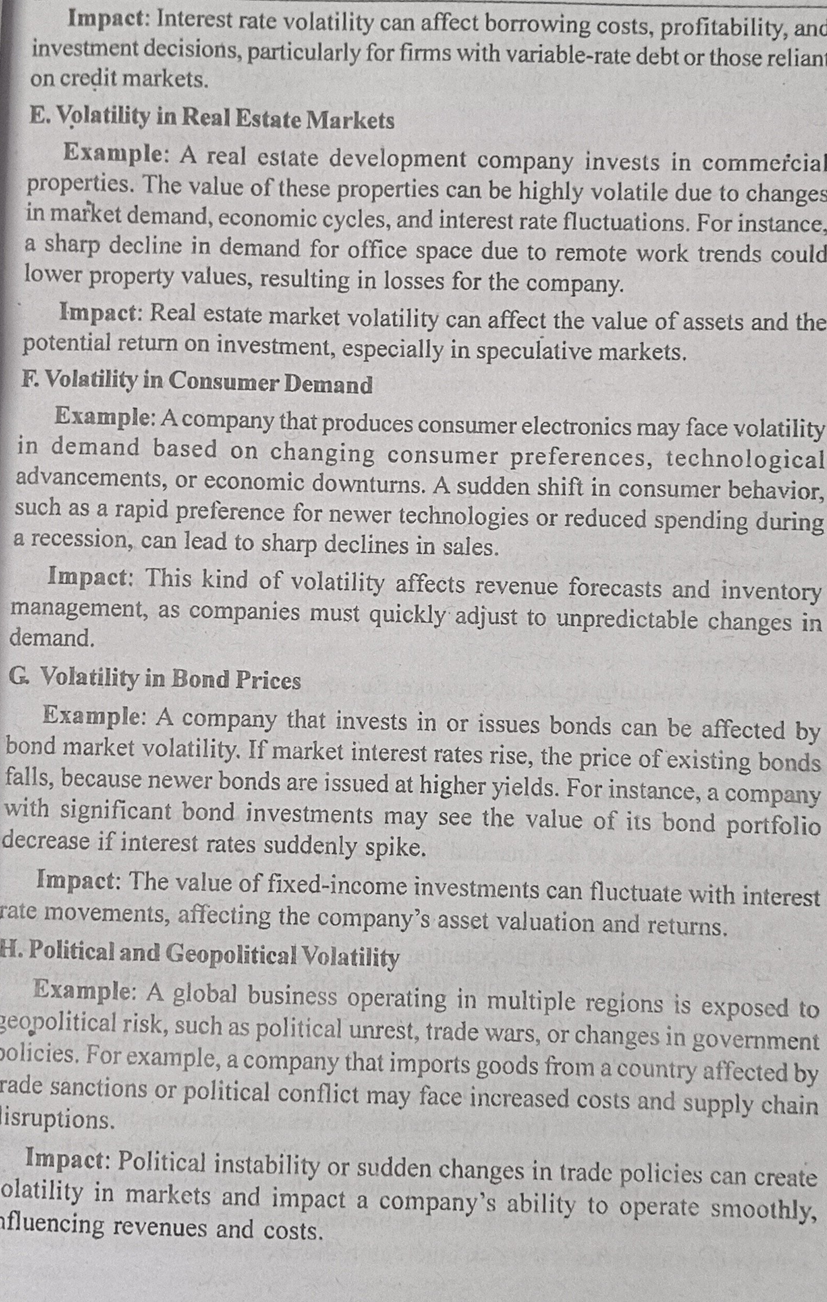
E. Volatility in Real Estate Markets
- Example: A real estate company experiences fluctuations in property values due to market demand and economic factors.
- Impact: Market volatility can lead to significant investment risks, particularly in speculative real estate sectors.
- Thoughts: Understanding trends in remote work and economic shifts is crucial for real estate firms to anticipate changes in demand for commercial properties.
F. Volatility in Consumer Demand
- Example: A consumer electronics company faces changing demand based on consumer preferences and economic conditions.
- Impact: This volatility influences sales, requiring quick adjustments in inventory and forecasting.
- Thoughts: Companies should focus on market research and consumer behavior analysis to stay ahead of trends, especially during downturns.
G. Volatility in Bond Prices
- Example: Companies that invest in bonds are affected by fluctuations in market interest rates, which impact the value of existing bonds.
- Impact: The valuation of fixed-income investments can vary with interest rate changes, affecting overall asset valuation.
- Thoughts: Firms should adopt a proactive approach to managing bond portfolios to mitigate risks associated with interest rate hikes.
H. Political and Geopolitical Volatility
- Example: Global businesses face risks from political instability and changes in trade policies, impacting import costs and supply chains.
- Impact: Political events can disrupt business operations and alter financial forecasts.
- Thoughts: Multinational companies need robust contingency plans to adapt to geopolitical risks, ensuring supply chain resilience and cost management.
Summary Table of Volatility Factors:
| Volatility Area | Example | Impact |
|---|---|---|
| Real Estate Markets | Fluctuating property values due to demand changes | Affects asset value and investment potential |
| Consumer Demand | Demand shifts for consumer electronics | Impacts revenue forecasts and inventory management |
| Bond Prices | Bond price fluctuations with interest rates | Alters fixed-income asset valuation |
| Political and Geopolitical Volatility | Risks from geopolitical changes | Disrupts operational efficiency and financial forecasting |
Extended readings:
Notes on Volatility in Business Contexts
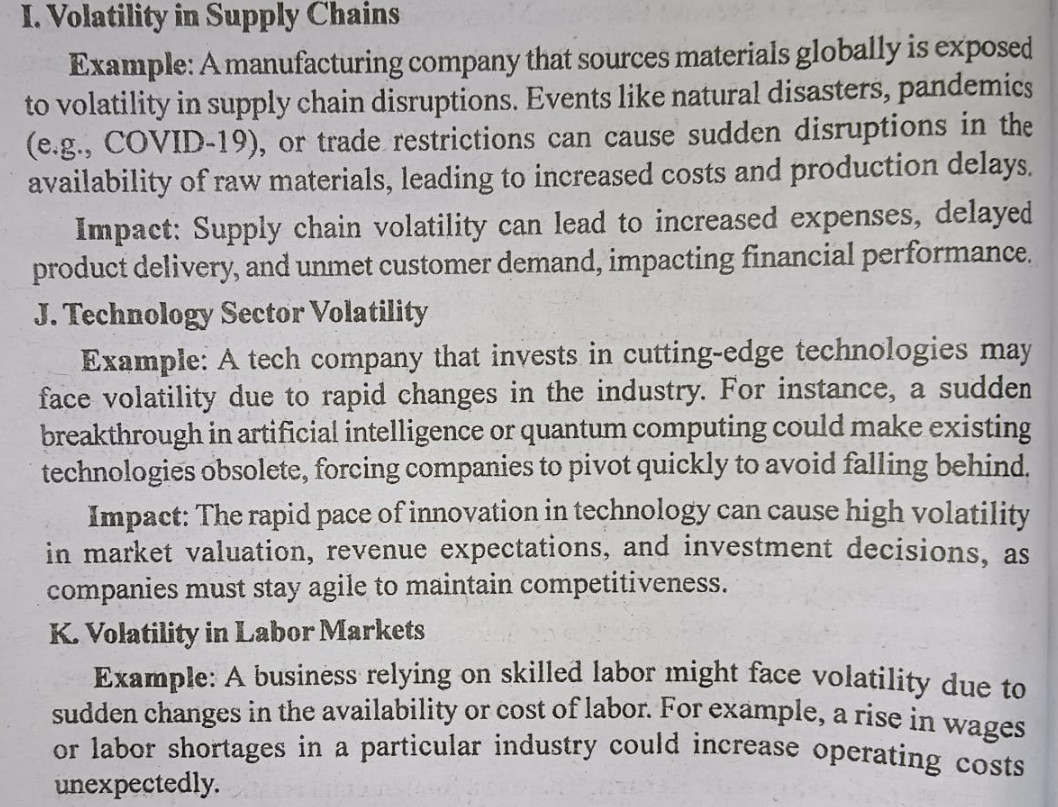
I. Volatility in Supply Chains
- Example: A manufacturing company sourcing materials globally may experience disruptions from events like natural disasters or pandemics (e.g., COVID-19) and trade restrictions.
- Impact: Increased expenses, delayed product delivery, and unmet customer demand can significantly affect financial performance.
- Thoughts: Companies should consider diversifying suppliers to minimize risks and develop contingency plans to ensure stability in supply chains.
J. Technology Sector Volatility
- Example: A tech company investing in cutting-edge technologies faces volatility due to rapid industry changes, such as breakthroughs in artificial intelligence or quantum computing.
- Impact: The quick pace of innovation can lead to fluctuations in market valuation, altered revenue expectations, and critical investment decisions.
- Thoughts: Staying agile and flexible in strategy can help companies remain competitive and capitalize on emerging technologies before they become mainstream.
K. Volatility in Labor Markets
- Example: Businesses relying on skilled labor may encounter volatility from changes in labor availability or costs, such as wage increases or labor shortages.
- Impact: Rising wages can lead to higher operating costs, potentially affecting profitability.
- Thoughts: Companies may need to invest in workforce development and improve retention strategies to manage labor costs effectively and reduce turnover.
Extended readings:
Notes on Volatility in Labor Markets and Decision-Making Impacts
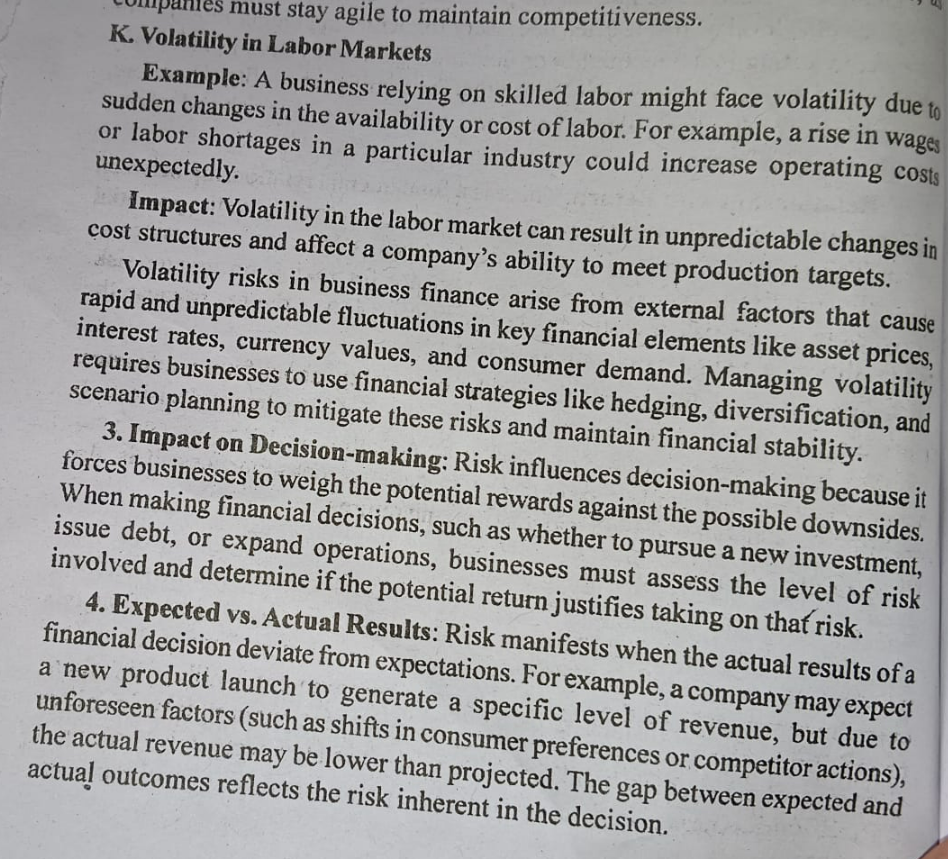
1. Volatility in Labor Markets
- Example: A company dependent on skilled labor can face volatility due to sudden changes in labor availability or costs, such as a wage increase or labor shortages.
- Thoughts: This highlights the importance of workforce management and forecasting labor needs to ensure smooth operations. Companies should invest in employee retention strategies to mitigate volatility.
- Impact: Labor market volatility can lead to unpredictable costs and affect a company's ability to meet production goals.
- Additional Information: Organizations need to be agile in adjusting employee numbers or compensation packages. Establishing a flexible labor strategy can help manage such risks.
2. Risk in Business Finance
- Overview: Volatility in finance stems from external influences, affecting elements like asset prices and consumer demand.
- Thoughts: Businesses must be aware of economic indicators and trends, ensuring that they adapt quickly to changing conditions.
- Management Strategies: To handle volatility, businesses can employ financial strategies like:
- Hedging: Protecting against losses by taking opposite positions in different markets.
- Diversification: Spreading investments across various sectors to reduce risk.
- Scenario Planning: Developing plans for potential future events to remain prepared.
3. Impact on Decision-Making
- Risk Assessment in Financial Decisions: Businesses must balance potential rewards with possible downsides when making financial choices.
- Thoughts: This necessitates a thorough analysis of risks associated with new investments or operational expansions, ensuring informed decision-making.
4. Expected vs. Actual Results
- Risk Manifestation: A divergence between projected outcomes and actual results can occur, particularly in product launches.
- Example: A firm may anticipate a certain level of revenue from a new product, but unforeseen circumstances can lead to lower actual results.
- Thoughts: This discrepancy underscores the necessity for realistic projections and flexibility in operational strategies. Companies should build contingency plans to address potential shortfalls.
- Example: A firm may anticipate a certain level of revenue from a new product, but unforeseen circumstances can lead to lower actual results.
Summary
Understanding labor market volatility, its impacts on decision-making, and how to manage associated risks is vital for businesses looking to maintain financial stability and operational efficiency. Companies should remain proactive in risk assessment and strategic planning to adapt to changing conditions effectively.
Extended readings:
Notes on Business Finance Risk
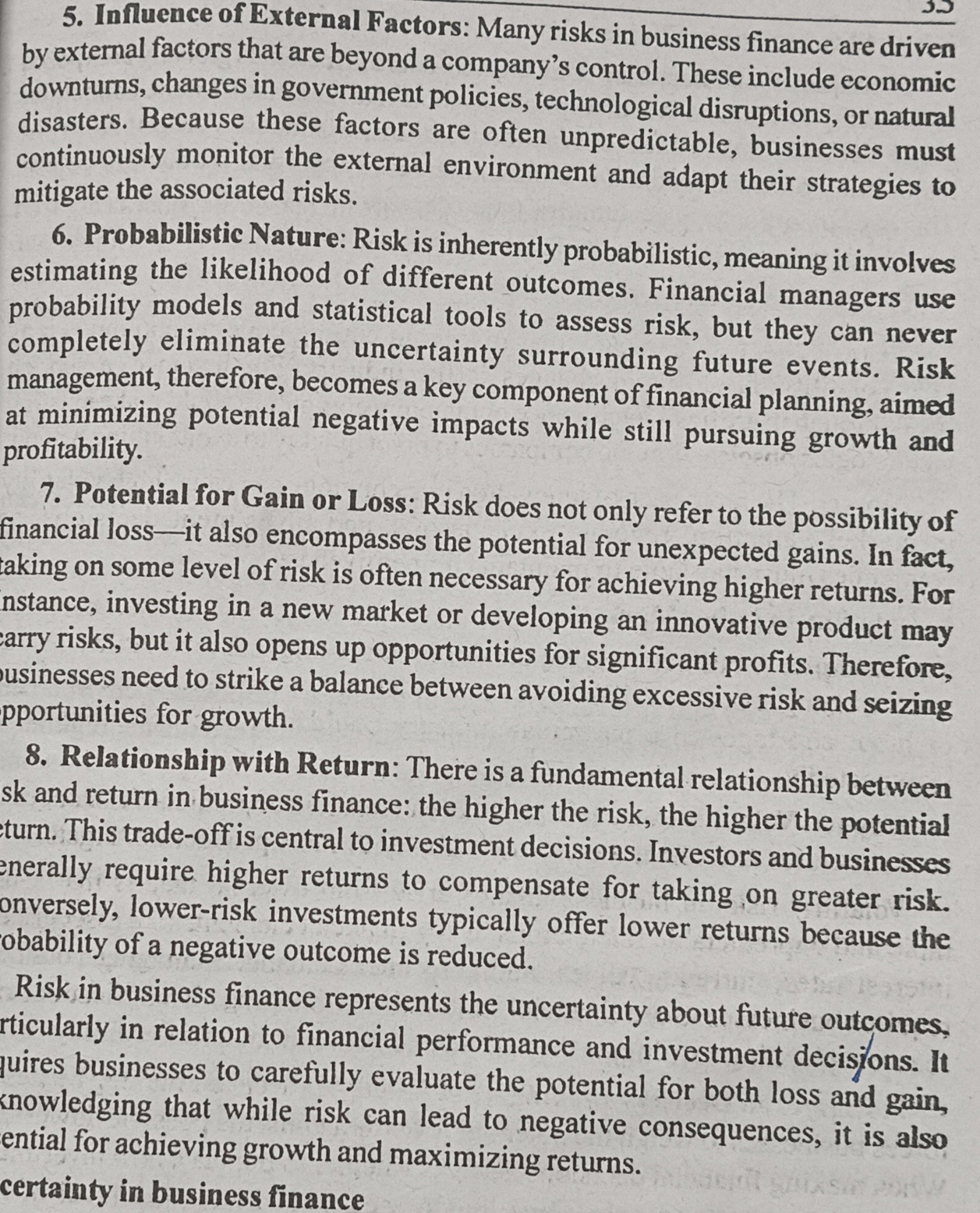
5. Influence of External Factors
- Key Point: Many risks in business finance arise from external factors beyond a company's control, such as economic downturns and technological disruptions.
- Thoughts: Businesses must not only identify these risks but also stay agile. Continuous monitoring of external environments allows companies to adapt their strategies effectively.
- Additional Information: Incorporating risk assessment into strategic planning can help mitigate potential losses associated with external shocks.
6. Probabilistic Nature
- Key Point: Risk involves estimating the likelihood of various outcomes using probability models.
- Thoughts: Financial managers must embrace uncertainty and leverage statistical tools to weigh different scenarios.
- Additional Information: Effective risk management helps in forecasting possible negative impacts while promoting growth opportunities, thus aligning with the company's risk appetite.
7. Potential for Gain or Loss
- Key Point: Risk includes both the possibility of financial loss and the potential for unexpected gains.
- Thoughts: To achieve high returns, businesses often need to engage in risk-taking behaviors.
- Additional Information: Innovative product development or entering new markets can yield high rewards, but must be balanced with the potential for loss.
8. Relationship with Return
- Key Point: A fundamental trade-off exists between risk and return in business finance.
- Thoughts: Investors typically expect higher returns for taking on more risk, which informs their investment strategies.
- Additional Information: Understanding this relationship is crucial for making informed investment decisions; lower-risk investments generally offer more security but at the cost of potentially lower returns.
Summary of Concepts
- Risk in Business Finance: Represents uncertainty regarding future outcomes, necessitating careful evaluation of potential losses and gains.
- Business Strategy: Businesses must balance risk and opportunity, aiming for growth while mitigating excessive exposure to risk.
These notes build upon the understanding that risk in finance encompasses a variety of factors, both quantifiable and unquantifiable, that impact decision-making and strategic planning.
Extended readings:
Notes on Relationship with Return and Uncertainty in Business Finance
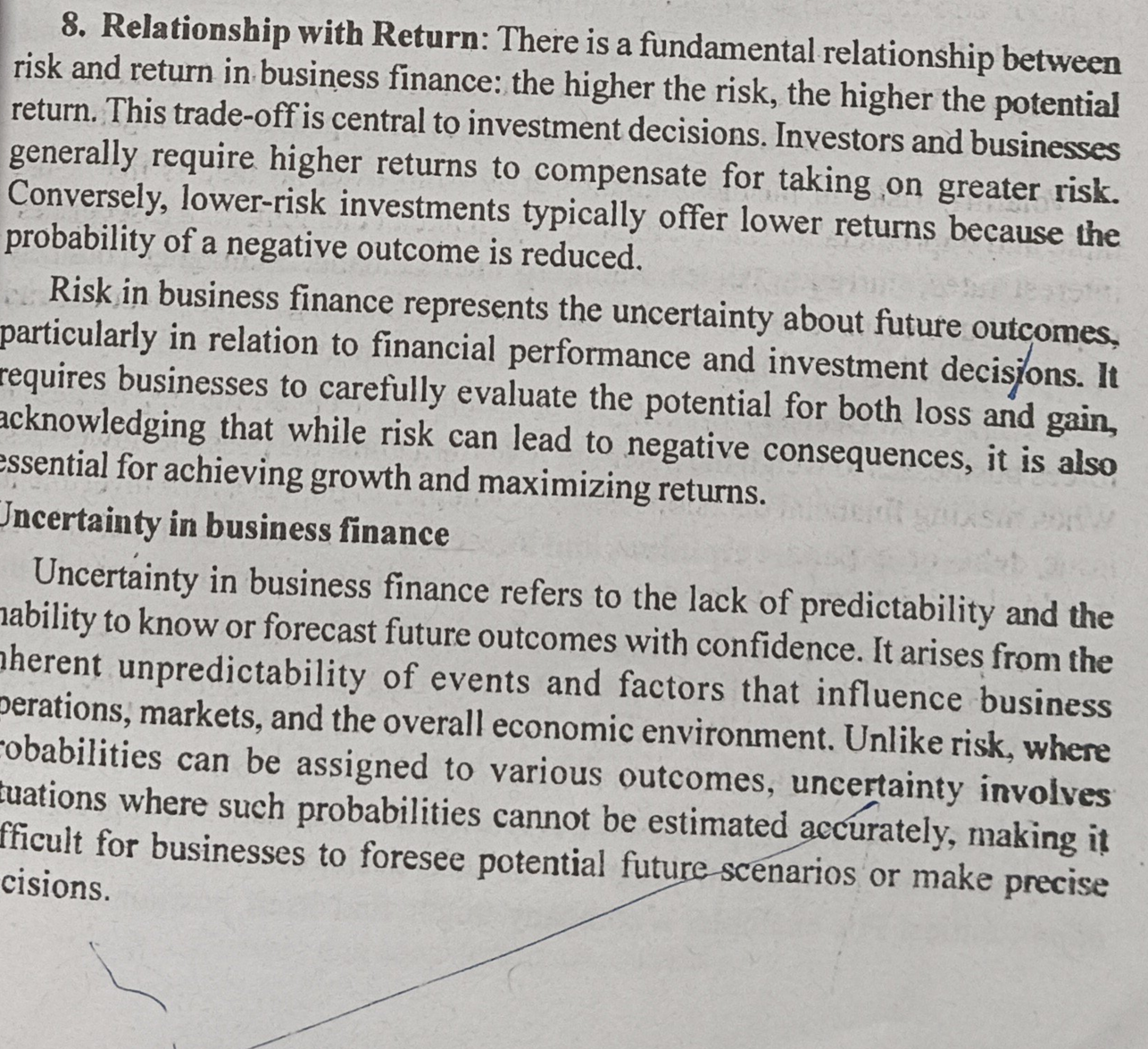
1. Relationship with Return
-
Fundamental Principle: There exists a direct relationship between risk and return in business finance. As risk increases, the potential return also increases.
- Thoughts: This trade-off is essential for investors when making decisions. Higher risks may deter some investors, while others might embrace them for the potential higher returns.
-
Investment Decisions: Investors and businesses generally prefer higher returns to justify higher risks.
- Additional Information: This can lead to a portfolio diversification strategy where different levels of risk are balanced against potential returns to optimize overall performance.
-
Lower-Risk Investments: Typically yield lower returns as they represent less uncertainty.
- Thoughts: Investors must decide their risk tolerance levels, defining whether they prefer steady, lower returns or are willing to absorb volatility for potentially larger gains.
2. Risk in Business Finance
- Definition: Risk in business finance concerns the uncertainty surrounding future financial performance, necessitating thorough evaluation when making investment decisions.
- Acknowledgment: While risk can lead to adverse outcomes, it is an integral part of achieving growth and maximizing returns.
3. Uncertainty in Business Finance
-
Concept: Uncertainty refers to the unpredictability of outcomes and the inability to forecast them with confidence.
- Thoughts: This aspect is especially challenging for businesses, as it complicates decision-making processes and strategic planning.
-
Sources of Uncertainty: Arises from unpredictable events and factors affecting business operations, markets, and the economic environment.
- Additional Information: Companies must be adaptable and responsive to external changes, investing in market research and forecasting to better navigate uncertainties.
-
Probabilities: Unlike risk, where probabilities can be assigned to outcomes, uncertainty involves scenarios where such probabilities remain unmeasurable.
- Implication: This inherent unpredictability can lead to significant difficulties in making informed business decisions, highlighting the need for agile strategies.
Summary
Understanding the intricate relationship between risk and return, alongside the elements of uncertainty, is crucial for effective decision-making in business finance. This knowledge aids in aligning business strategies with market realities, ultimately contributing to achieving long-term success and growth.
Extended readings:
Key Characteristics of Uncertainty in Business Finance
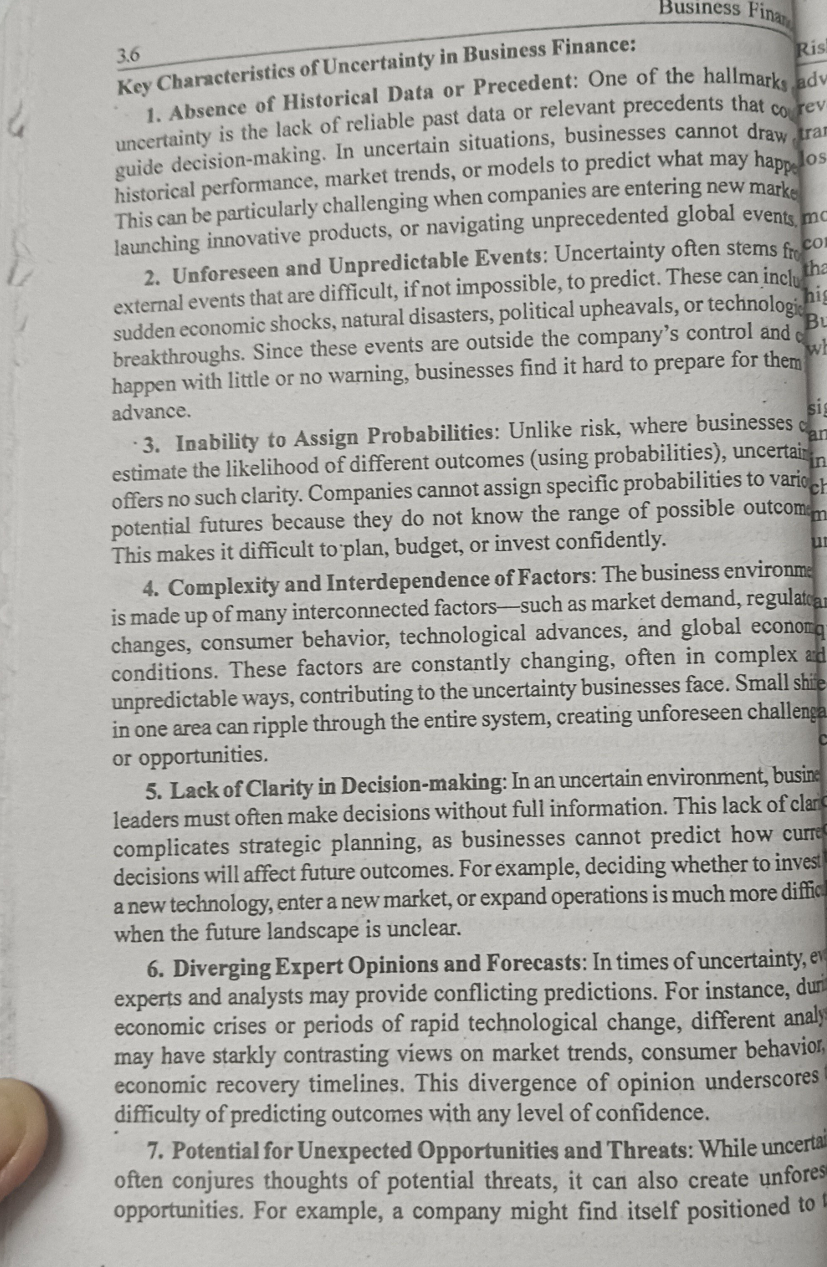
-
Absence of Historical Data or Precedent
- Thoughts: Businesses often rely on historical data to guide their decisions. The lack of reliable past data means that companies cannot effectively predict future performance, which is critical when venturing into new markets or launching innovative products.
- Additional Information: This situation is particularly relevant during economic downturns or in industries undergoing rapid change. Without benchmarks, firms may adopt more conservative strategies, potentially missing opportunities.
-
Unforeseen and Unpredictable Events
- Thoughts: Events such as economic shocks or natural disasters can drastically affect business operations, often with little notice. This unpredictability demands agile strategies and risk management plans.
- Additional Information: Companies should develop contingency plans and emergency response strategies to mitigate the impact of such unforeseen events.
-
Inability to Assign Probabilities
- Thoughts: Unlike risk, which can be quantified, uncertainty makes it challenging to assign probabilities to potential outcomes. This ambiguity complicates financial planning and investment decisions.
- Additional Information: Businesses can benefit from scenario analysis and stress testing to explore potential outcomes, even if they cannot assign precise probabilities.
-
Complexity and Interdependence of Factors
- Thoughts: The interconnected nature of the business environment means that changes in one area can affect others, leading to cascading uncertainties. Companies must understand these relationships to navigate risks.
- Additional Information: A holistic approach to risk management that considers external and internal factors is vital. Leveraging data analytics can help businesses identify patterns and interdependencies.
-
Lack of Clarity in Decision-making
- Thoughts: Uncertainty breeds indecision. Business leaders must often operate with incomplete information, impacting strategic planning.
- Additional Information: Companies can enhance decision-making by incorporating flexible strategies that allow for adjustment as new information emerges.
-
Diverging Expert Opinions and Forecasts
- Thoughts: In uncertain times, experts may offer conflicting predictions, which can lead to confusion and hesitation in decision-making. Organizations should weigh multiple viewpoints critically.
- Additional Information: Establishing a diverse advisory panel could provide a broader perspective and mitigate the risks associated with relying on a single forecast.
-
Potential for Unexpected Opportunities and Threats
- Thoughts: While uncertainty often highlights risks, it can also unveil hidden opportunities. Companies should remain vigilant and adaptable to leverage these potential benefits.
- Additional Information: Investing in innovation and market research can help firms identify and seize unexpected opportunities, turning uncertainty into a competitive advantage.
Extended readings:
Notes on Uncertainty in Business Strategies and Risk Management
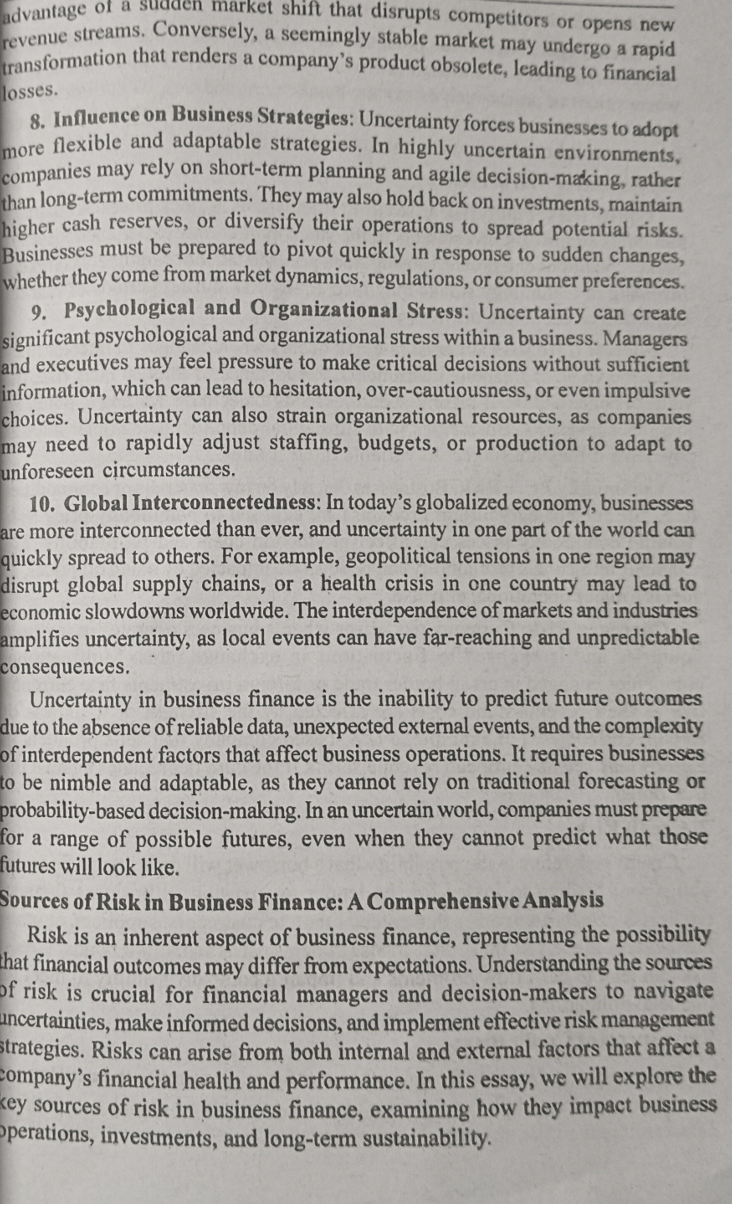
8. Influence on Business Strategies
- Flexible and Adaptive Strategies: In uncertain environments, businesses must adopt methodologies that allow them to respond to quick changes in the market. This means favoring short-term planning and agile decision-making to remain competitive.
- Thoughts: Traditional long-term planning becomes less relevant when market dynamics fluctuate frequently. Companies should invest in real-time data analytics to assist with rapid decision-making.
- Investment Approaches: Many businesses may choose to delay large investments and instead focus on maintaining cash reserves or diversifying their operations to mitigate potential risks.
- Idea: Creating strategic partnerships or collaborations can also help share risks and resources across industries.
9. Psychological and Organizational Stress
- Internal Pressure on Executives: Decision-makers often face stress due to uncertainty. The need to make critical choices without sufficient data can result in hesitation or impulsive actions.
- Understanding Stress Factors: Organizations might benefit from leadership training that focuses on managing stress and making decisions under pressure. Psychological safety should be cultivated to allow open dialogue.
- Resource Allocation Challenges: Organizations may experience strain in staffing and budgeting, making it difficult to adapt to new circumstances.
- Additional Insight: Companies should consider implementing agile methodologies for better resource management and adaptation during unpredictable phases.
10. Global Interconnectedness
- Impact of Global Events: Uncertainty in one region can trigger complications worldwide, showcasing the need for awareness of global socio-economic factors.
- Broader Context: Businesses should engage in global market analysis to foresee how changes in one area can affect their operations elsewhere, fostering resilience.
- Interdependence of Markets: The interconnected nature of markets means that localized events can have sweeping implications, emphasizing the importance of global strategy development.
- Strategic Adaptation: Diversifying supply chains can help businesses mitigate risks associated with global disruptions.
Uncertainty in Business Finance
- Definition: Uncertainty in finance relates to potential discrepancies between expected and actual outcomes due to a lack of reliable data and unforeseen events.
- Key Takeaway: Businesses must embrace flexibility and adaptability in their forecasting and planning processes.
- Risk Complexity: The intricate web of interdependent factors requires companies to prepare for a range of possible futures rather than relying solely on historical data.
- Strategic Recommendations: Scenario planning and stress testing can help organizations prepare for various potential futures and enhance their strategic planning.
Sources of Risk in Business Finance
- Inherent Nature of Risk: Understanding the sources of risk is vital for financial decision-makers. These can be internal (organizational structure, operational processes) or external (market conditions, regulatory changes).
- Exploration of Risks: Regular assessments and updates to risk management strategies can better safeguard against financial uncertainties.
- Impact on Long-term Sustainability: All risks can affect a company's financial health, necessitating vigilant monitoring and strategic adjustment to maintain long-term viability.
- Future Readiness: Businesses should prioritize having a robust risk management framework integrated within their overall organizational strategy.
Extended readings:
Notes on Market and Credit Risk
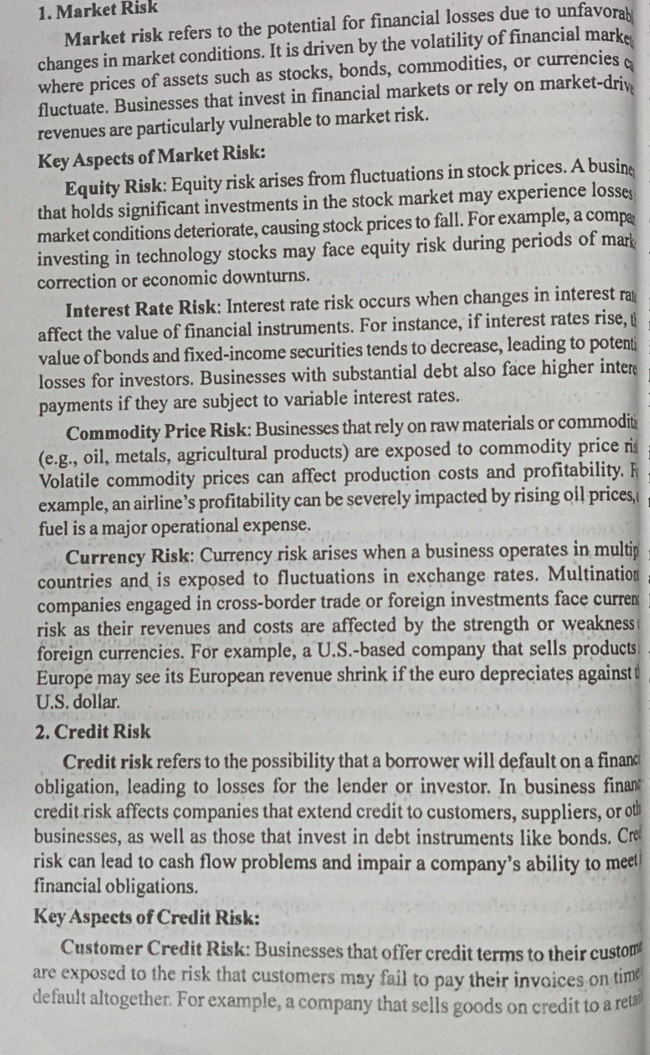
1. Market Risk
Market risk entails the potential for financial losses due to unfavorable changes in market conditions, influenced by the volatility present in various asset classes such as stocks and commodities. Understanding this risk is vital for businesses, particularly those highly invested in market-driven revenues.
Key Aspects of Market Risk:
Equity Risk
- Definition: This risk arises from fluctuations in stock prices, particularly affecting businesses with significant stock market investments.
- Thoughts: Investing heavily in stocks during volatile periods may lead to severe financial downturns, especially for tech companies that can be subject to rapid changes in market perception.
Interest Rate Risk
- Definition: Changes in interest rates can affect the value of financial instruments, impacting both bonds and fixed-income securities.
- Thoughts: Companies with substantial debt are particularly vulnerable, as rising interest rates not only decrease bond values but also increase their debt servicing costs, potentially leading to cash flow issues.
Commodity Price Risk
- Definition: Businesses reliant on raw materials are subject to fluctuations in commodity prices (e.g., oil, metals).
- Thoughts: An increase in commodity prices can dramatically impact production costs and profitability. For instance, airlines may see profit margins shrink due to rising fuel costs.
Currency Risk
- Definition: This risk emerges when firms operate in multiple countries, facing fluctuations in exchange rates.
- Thoughts: For multinational companies, currency depreciation can significantly reduce revenues from foreign markets, which highlights the importance of effective hedging strategies.
2. Credit Risk
Credit risk refers to the likelihood that a borrower may default on a financial obligation, leading to potential losses for lenders or investors.
Key Aspects of Credit Risk:
Customer Credit Risk
- Definition: This is the risk that customers fail to fulfill their payment obligations.
- Thoughts: Businesses that extend credit to customers must implement thorough credit assessments. A default can lead to cash flow problems, affecting the company's operational capacity and financial health.
Summary
Understanding both market and credit risks is crucial for businesses aiming for effective financial decision-making and risk management strategies. Market risks can severely impact revenues and investment strategies, while credit risks necessitate diligent monitoring of customer financial health and payment histories. Companies must develop comprehensive strategies to mitigate these risks and enhance financial resilience in volatile market conditions.
Extended readings:
Notes on Risk Management in Business
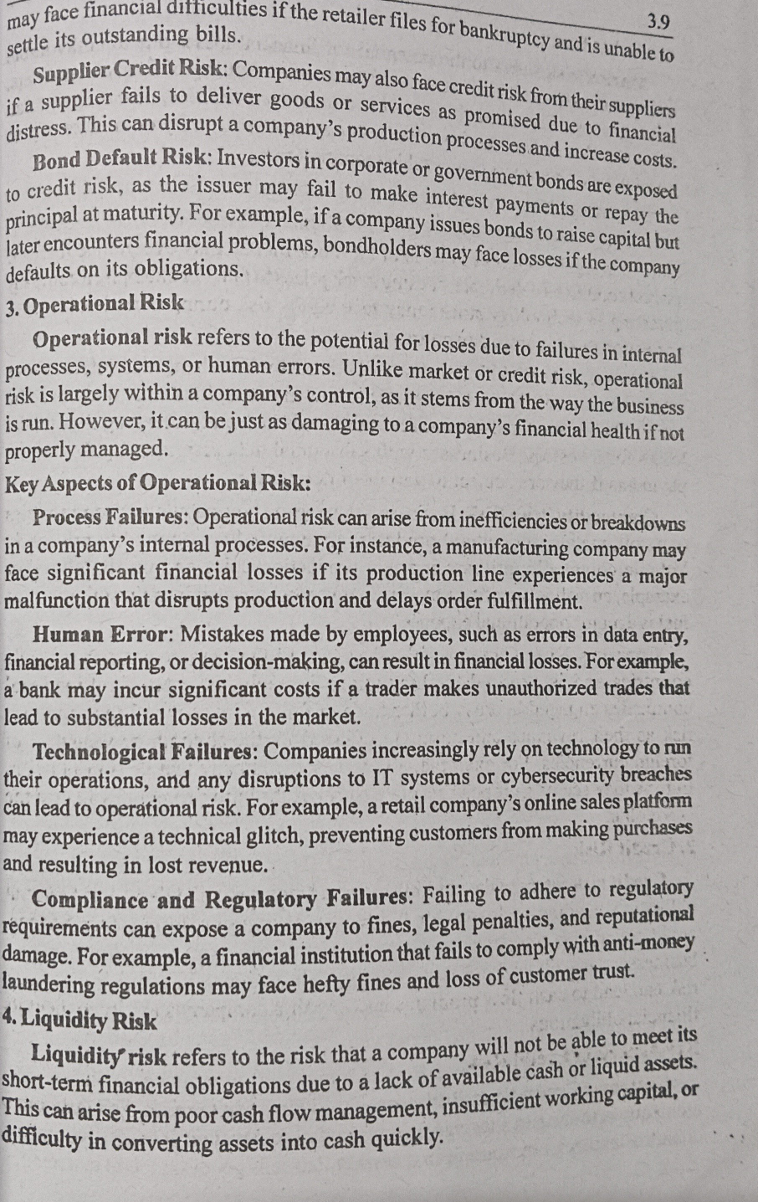
1. Supplier Credit Risk
- Definition: This refers to the financial risk a company faces if a supplier fails to deliver goods or services as promised due to financial issues.
- Thoughts: The reliability of suppliers is critical for maintaining production schedules. Companies should assess supplier stability and potentially diversify their supplier base to mitigate this risk.
2. Bond Default Risk
- Definition: Investors in corporate or government bonds may experience losses if the issuer defaults on interest payments or principal repayment.
- Thoughts: Companies must maintain financial health to meet these obligations. Regular assessments of a company’s financial stability can help investors make informed decisions. Risk diversification in bond investment can also reduce potential losses.
3. Operational Risk
- Definition: Refers to the potential for losses due to failures in internal processes, systems, or human errors.
- Thoughts: While operational risk is primarily controllable, companies must develop robust processes and training programs to minimize risks associated with inefficiencies.
Key Aspects of Operational Risk:
| Aspect | Description |
|---|---|
| Process Failures | Inefficiencies or breakdowns in internal processes can lead to significant financial losses. |
| Human Error | Employee mistakes in critical operations can incur substantial costs. |
| Technological Failures | Disruptions in IT systems or cyber breaches can impact operations and lead to lost revenue. |
| Compliance and Regulatory Failures | Non-compliance with regulations can result in fines and damage to reputation. |
4. Liquidity Risk
- Definition: The risk that a company cannot meet short-term financial obligations due to a lack of liquid assets.
- Thoughts: Companies should carefully manage cash flow and maintain sufficient working capital to avoid liquidity crises. Regular financial reviews can help identify potential liquidity issues early.
Extended readings:
Liquidity and Strategic Risk
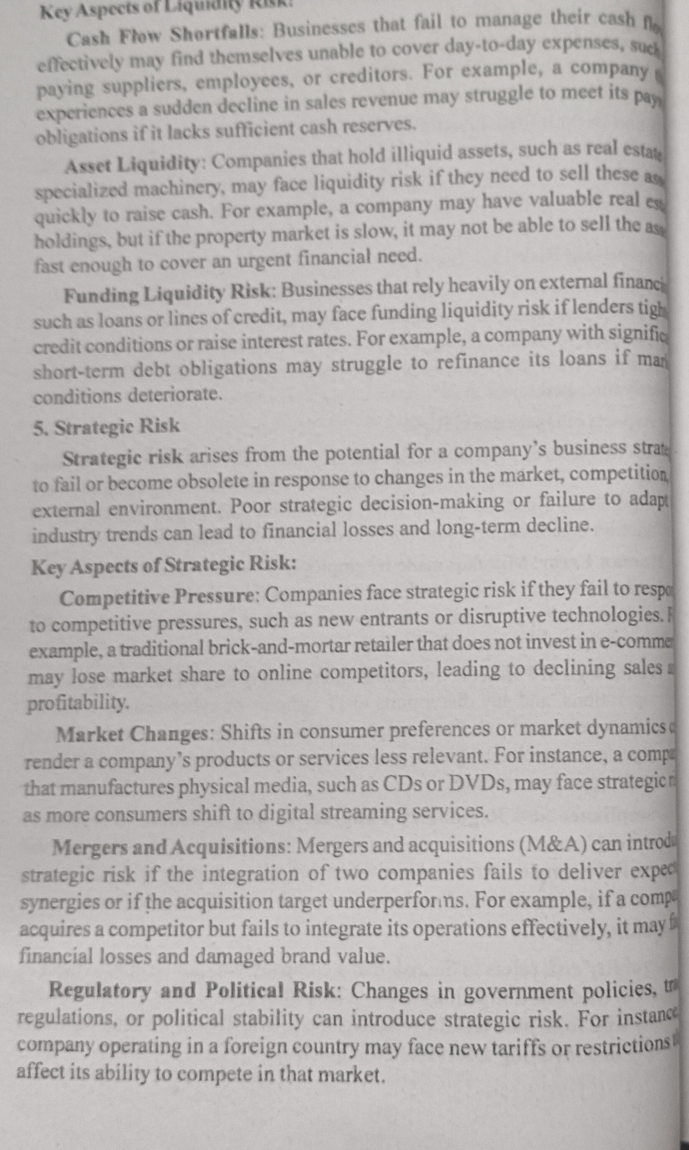
Key Aspects of Liquidity Risk
1. Cash Flow Shortfalls
- Description: This risk occurs when businesses cannot meet day-to-day obligations such as paying suppliers, employees, or creditors.
- Thoughts: Maintaining a healthy cash flow is crucial for operational stability. Companies should implement robust cash flow management strategies to forecast and mitigate potential shortfalls.
2. Asset Liquidity
- Description: Companies holding illiquid assets (e.g., real estate or specialized machinery) may struggle to sell them quickly for cash.
- Thoughts: It's important for businesses to assess their asset liquidity, especially in times of urgent financial needs. This may involve diversifying asset portfolios to include more liquid investments.
3. Funding Liquidity Risk
- Description: This arises for businesses that depend on external financing, like loans or lines of credit, which can be impacted by tightened credit conditions.
- Thoughts: Businesses should build relationships with multiple financial institutions to ensure access to funding options when necessary. Contingency plans for refinancing should also be in place.
Strategic Risk
1. Definition
- Description: Strategic risk is related to the potential failures of a company's business strategy or becoming obsolete due to market changes and competition.
- Thoughts: Regular strategic reviews and scenario planning can help organizations adapt to changes quickly and reduce strategic risk.
Key Aspects of Strategic Risk
1. Competitive Pressure
- Description: Companies face this risk when they do not adequately respond to competitive challenges, such as new market entrants or disruptive technologies.
- Thoughts: Staying updated on industry trends and investing in innovation can help mitigate this risk. Companies should also foster a culture of agility and responsiveness.
2. Market Changes
- Description: Shifts in consumer preferences can make products or services less relevant, impacting sales and profitability.
- Thoughts: Conducting regular market research can help businesses stay aligned with consumer needs and adjust their offerings accordingly.
3. Mergers and Acquisitions
- Description: M&A activities can pose risks if the integration fails to create expected synergies or if the target company underperforms.
- Thoughts: Thorough due diligence and post-merger integration strategies are essential for minimizing risks associated with M&A.
4. Regulatory and Political Risk
- Description: Changes in regulations or political instability can introduce risks for companies operating in foreign markets.
- Thoughts: Companies should actively monitor political environments and regulatory changes to mitigate potential disruptions. Engaging with local stakeholders can also help navigate these challenges.
Extended readings: